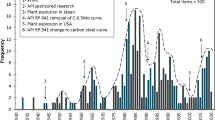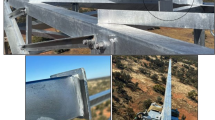Abstract
The fractographic analysis of the corrosion damage of the pipe surface of the distribution gas pipeline after 40 and 56 years of operation is performed. The mechanisms of formation of corrosion pits, laminations, and deep crack-like defects are systematized. On the basis of laboratory studies, which simulate operation conditions of a distribution gas pipeline in corrosive medium, the basic regularities in general corrosion of steel St. 3 in neutral chloride electrolytes are determined, depending on the value of the current density and chemical composition of the medium.






Similar content being viewed by others
References
A. Ebrahimi-Moghadam, M. Farzaneh-Gord, M. Deymi-Dashtebayaz, Correlations for estimating natural gas leakage from above-ground and buried urban distribution pipelines. J. Nat. Gas Sci. Eng. 34, 185–196 (2016)
P. Maruschak, R. Bishchak, I. Konovalenko, A. Menou, J. Brezinová, Effect of long term operation on degradation of material of main gas pipelines. Mater. Sci. Forum 782, 279–283 (2014)
A. Contreras, S.L. Hernandez, R. Orozco-Cruz, R. Galvan-Martinez, Mechanical and environmental effects on stress corrosion cracking of low carbon pipeline steel in a soil solution. Mater. Des. 35, 281–289 (2012)
A. Eslami, R. Eadie, W. Chen, Effect of oxygen on near-neutral pH stress corrosion crack initiation under a simulated tape coating disbondment. Can. Metall. Q. 55(2), 177–185 (2016)
G.P. Cimellaro, D. Solari, Considerations about the optimal period range to evaluate the weight coefficient of coupled resilience index. Eng. Struct. 69, 12–24 (2014)
C.R.F. Azevedo, Failure analysis of a crude oil pipeline. Eng. Fail. Anal. 14(6), 978–994 (2007)
J.D. Bernal, R.H. Fowler, A theory of water and ionic solution, with particular reference to hydrogen and hydroxyl ions. J. Chem. Phys. 1, 515–548 (1933)
H.M. Nykyforchyn, K.J. Kurzydlowski, E. Lunarska, Hydrogen degradation of steels in long-term service conditions. Environ. Induc. Crack. Mater. 2, 349–361 (2008)
V. Cicek, Corrosion Engineering and Cathodic Protection Handbook: With an Extensive Question and Answer Section (Wiley, Hoboken, 2017)
L. Poberezhny, H. Pryslipska, Electrocorrosion degradation of gas pipelines in highly mineralized soils. J. Ternopil Natl. Tech. Univ. 79(3), 71–77 (2015). (in Ukrainian)
Author information
Authors and Affiliations
Corresponding author
Rights and permissions
About this article
Cite this article
Maruschak, P., Poberezny, L., Prentkovskis, O. et al. Physical and Mechanical Aspects of Corrosion Damage of Distribution Gas Pipelines After Long-Term Operation. J Fail. Anal. and Preven. 18, 562–567 (2018). https://doi.org/10.1007/s11668-018-0439-z
Received:
Published:
Issue Date:
DOI: https://doi.org/10.1007/s11668-018-0439-z




